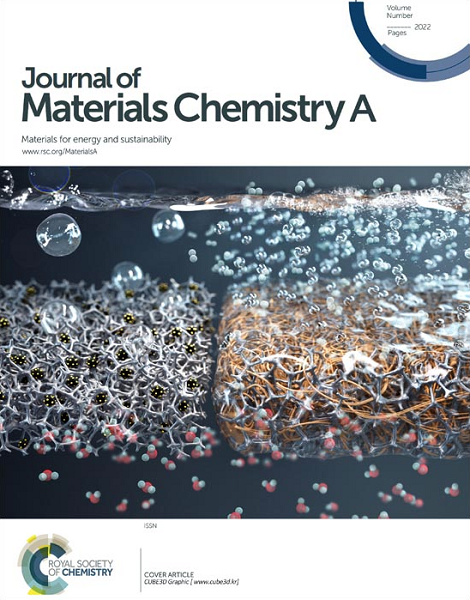介孔金属锆-有机骨架吸湿盐的研究
IF 9.5
2区 材料科学
Q1 CHEMISTRY, PHYSICAL
引用次数: 0
摘要
高度稳定的锆基金属有机骨架(Zr-MOFs)由于其优异的化学和水解稳定性,已成为在大气集水应用中构建“多孔基质复合盐”(CSPM)吸附剂的有前途的基质。然而,目前的实现仍然很大程度上局限于有限数量的微孔结构,这些微孔结构受到孔体积限制和次优吸附动力学的影响。为了解决这些关键的限制,我们提出了一个新的入口,通过将吸湿性CaCl2合理地整合到介孔NJTech-4中-一种具有显着的水蒸气循环稳定性的Zr-MOF。系统地结合氯化钙与不同的负载(20-50 wt%),使吸湿性能的精确优化。工程复合材料NJTech-4-Ca10 (38.4 wt% CaCl2载荷)在30%相对湿度下达到610 mg g(毒血症)的高吸水能力,比原始框架提高了12倍。更重要的是,这种复合材料表现出快速的吸附-解吸动力学,在60分钟内的工作能力为365 mg g - 1,这是一个关键的进步,可以实现多次的每日收获周期。本文章由计算机程序翻译,如有差异,请以英文原文为准。
Hygroscopic Salt in A Mesoporous Zirconium Metal−Organic Framework for Atmospheric Water Harvesting
Highly stable zirconium-based metal-organic frameworks (Zr-MOFs) have emerged as promising matrices for constructing "composite salt in porous matrix" (CSPM) adsorbents in atmospheric water harvesting applications, owing to their exceptional chemical and hydrolytic stability. However, current implementations remain largely confined to a limited number of microporous architectures that suffer from restricted pore volumes and suboptimal adsorption kinetics. To address these critical limitations, we present a new entry through the rational integration of hygroscopic CaCl2 into mesoporous NJTech-4 - a Zr-MOF demonstrating remarkable water-vapor cycling stability. Systematic incorporation of calcium chloride with varying loadings (20-50 wt%) enables precise optimization of hygroscopic performance. The engineered composite NJTech-4-Ca10 (38.4 wt% CaCl2 loading) achieves a high water uptake capacity of 610 mg g⁻¹ at 30% relative humidity, representing a 12-fold enhancement over the pristine framework. More significantly, this composite demonstrates fast adsorption-desorption kinetics with a working capacity of 365 mg g⁻¹ within 60 minutes - a critical advancement enabling multiple daily harvesting cycles.
求助全文
通过发布文献求助,成功后即可免费获取论文全文。
去求助
来源期刊

Journal of Materials Chemistry A
CHEMISTRY, PHYSICAL-ENERGY & FUELS
CiteScore
19.50
自引率
5.00%
发文量
1892
审稿时长
1.5 months
期刊介绍:
The Journal of Materials Chemistry A, B & C covers a wide range of high-quality studies in the field of materials chemistry, with each section focusing on specific applications of the materials studied. Journal of Materials Chemistry A emphasizes applications in energy and sustainability, including topics such as artificial photosynthesis, batteries, and fuel cells. Journal of Materials Chemistry B focuses on applications in biology and medicine, while Journal of Materials Chemistry C covers applications in optical, magnetic, and electronic devices. Example topic areas within the scope of Journal of Materials Chemistry A include catalysis, green/sustainable materials, sensors, and water treatment, among others.
 求助内容:
求助内容: 应助结果提醒方式:
应助结果提醒方式:


